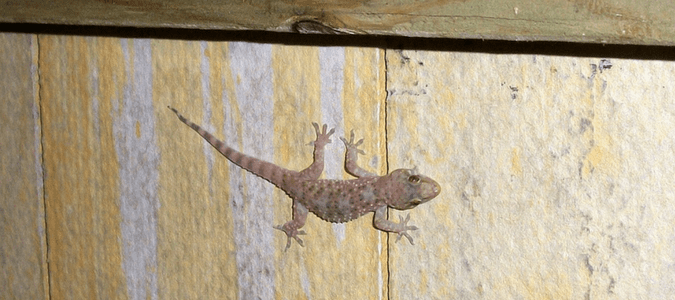
What’s that hanging around your porch light in the evenings, particularly in the warmer months? Most likely, it’s a gecko.
In this post, we’ll tell you what you need to know about geckos in Texas, how to get rid of them (if that’s what you decide to do) and how to prevent them from coming back again. Read on to learn more about this reptile.
What You’ll Learn:
What Is A Gecko?
Is a gecko a lizard? Technically, yes. Geckos are small lizards that belong to the Gekkonidae family. While geckos are lizards, a few characteristics set them apart from other reptiles. The common household gecko has bulging, lidless eyes and sticky toepads. These toepads allow geckos to climb walls and even move across ceilings. These crawling creatures are typically between three and six inches in length. Geckos can shed their skin, although they usually eat it afterwards, as it contains nutrients. Males are often much larger than females. This reptile’s color ranges from pink to gray and some species can have dark patches of color, although its belly is typically a creamy-white.
The gecko has also developed physical characteristics to help them avoid and survive predators. Its tail, for example, which tapers off at the end of the body, helps the gecko balance its weight while climbing and also acts as a fuel tank to store fat. The gecko uses its tail for camouflage to remain unseen by prey and to hide from predators.
If a predator does see the gecko and tries to attack, its tail can be shed if a predator grabs it, allowing the gecko more time to get away. The tail by itself isn’t necessarily what fools the predator—it’s the fact that the tail continues to move after it is separated from the body that can distract another animal long enough for the gecko to get away. A gecko may return to eat the tail it shed after the encounter, since, like the skin, the tail stores nutrients.
What Do Geckos Eat?
If you’ve seen an animal lurking near porch lights at night, you’ve probably seen a common house gecko waiting for its prey: bugs that are attracted to light. Being nocturnal animals, these reptiles seek their prey at night. In darkness, the gecko’s irises grow bigger to help them see, which makes these reptiles’ eyes 350 times more sensitive to light than the human eye. As we mentioned earlier, geckos don’t have eyelids; instead, they have transparent membranes that they lick to keep clean. Geckos tend to stay near porch lights or other light sources around your home while they wait for insects they eat, like moths and cockroaches. They can also be found around your home’s exterior or in cracks and crevices in your home’s structure – all the more reason to keep your foundation maintained.
You’re most likely to see geckos around your home during the spring, summer and even fall months depending on the region you live in, as they prefer hot, tropical climates. You might, however, notice clusters of white, oval-shaped eggs at any time throughout the year.
Some homeowners welcome geckos into their homes because of the reptile’s ability to keep other insects at bay. In fact, the sight of a gecko can be considered good luck in some cultures. Like we mentioned above, they like to prey on moths and cockroaches, but they also feed on other unwanted pests like mosquitoes and spiders.
One complaint about geckos is that they can make quite a bit of noise. Although some calls are inaudible to humans, the sounds associated with a courtship display are sometimes described as barking and sometimes as squeaks, chirps and clicks. Some homeowners find their presence to simply be a nuisance; the idea of a reptile roaming free around their home isn’t something they can handle. So, are geckos poisonous? No – geckos can’t physically harm or hurt humans. However, gecko droppings can stain fabrics, carpets and curtains.
How To Get Rid Of Geckos
If you’d prefer to keep your home gecko-free, there are a few things you can do to remove them from your property. For starters, remove any possible food source. Do this by turning off your outdoor lights for a few days. Light attracts insects geckos eat, and without that light, there will be no insects, eliminating your home’s appeal. If you need to keep your lights on at night, consider installing yellow bulbs or sodium vapor lights.
Another way to keep geckos out is to secure your home’s entryways. Like many rodents, geckos find their way indoors through small cracks and crevices around wooden structures. Consider installing weather strips around doors and windows, and be sure to seal off possible openings around plumbing and electrical outlets.
ABC Can Keep Any Critter Away
If you continue to find geckos inside your home, give ABC Home & Commercial Services a call. Our team of experts has the knowledge and training to properly assess and manage any problem or infestation. Our technicians will inspect your home at a time convenient for you and then provide you with a customized treatment plan you can count on. Before we leave, we’ll ensure your home is—and remains—pest-free.
